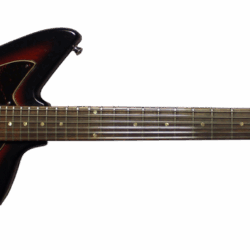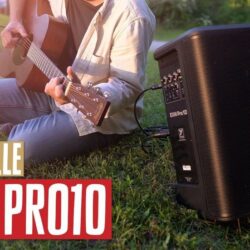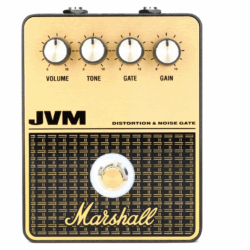
Full Album Stream: Hebephrenique –Decathexis
Aussie post-black metal madmen Hebephrenique are going off the rails on their frenetic debut Decathexis.
The post Full Album Stream: Hebephrenique –Decathexis appeared first on Decibel Magazine.

Stun with Tapped Harmonics! #tappedharmonics #tapping #guitarharmonics
For the full tutorial on tapped harmonics visit: https://www.guitarworld.com/lessons/techniques/tapped-harmonics #tappedharmonics #eddievanhalen #guitarharmonics
Read more »
Soloing with the metronome’s click on beats 2 and 4. #metronome #timekeeping #guitartechnique
Every guitar player can benefit from a metronome! For the full lesson with tab, visit: https://www.guitarworld.com/lessons/techniques/how-to-use-a-metronome-for-guitar #metronome #timekeeping #playintime #guitarlesson
Read more »
Ty Myers Rig Rundown
The TikTok star goes legit on his latest tour with some plum Strats, a Two-Rock, and a masterbuilt pedalboard.When Ty Myers got injured a few years back and couldn’t play sports, he took to posting videos of himself on TikTok. Before long, his song “Tie That Binds” went viral on the platform, blasting him to overnight-star status. Now, with his debut album, The Select, under his belt, the 18-year-old is taking his songs on the road to packed-out rooms.PG’s John Bohlinger linked with country’s newest wunderkind at the Egyptian Room in Indianapolis to see how he brings his old-time-meets-new-world country to life onstage.Brought to you by D’Addario.San Antonio StratThis Fender Stratocaster, the first nice guitar Myers bought himself, was purchased from a guy in a Home Depot parking lot in San Antonio, Texas. Myers swapped in Fender Custom Shop Fat ’50s pickups, and he strings it with Stringjoy .010s.Eye-Catching CustomIf Myers played slide, it’d be with this Custom Shop Master Built Strat, built by Dale Wilson. He went to Carter’s Vintage in Nashville with another instrument in mind, but this one caught his eye, and he had to have it. He kept the pickups it came with, and pretty soon he intends to have the action lowered.Barry’s BondMyers got his first Gibson SJ-200 around the age of 10, and this one, a gift from label executive Barry Weiss, is his current go-to. It’s got an LR Baggs pickup system and goes direct to front-of-house.Package DealMyers’ biggest hero is John Mayer, so it tracks that he went after this Two-Rock Silver Sterling Signature. He saw this one at Carter the same day he bought his Custom Shop Strat, and didn’t even plug it in—he just bought it along with the Master Built. Ty Myers’ PedalboardMyers’ stomp station was built by the pedal professors at XAct Tone Solutions in Nashville. After the Dunlop Volume (X) Mini and the Peterson StroboStomp LE, Myers’ signal hits an Origin Effects Cali76, JHS Pedals Berkeley, Keeley Katana, Analog Man/Boss GE-7, Greer Lightspeed, MXR Duke of Tone, Browne Amplification Protein, Keeley Noble Screamer, Boss VB-2w, Boss TR-2, JHS Flight Delay, and EarthQuaker Devices Dispatch Master. A Strymon Zuma and Strymon Ojai keep the lights on.Fender Custom Shop Masterbuilt StratocasterFender StratocasterGibson SJ-200Dunlop Volume (X) MiniPeterson StroboStomp LEOrigin Effects Cali76JHS Pedals BerkeleyKeeley KatanaBoss GE-7 7-band EQ PedalMXR Duke of ToneKeeley Noble ScreamerBoss VB-2wBoss TR-2JHS Flight DelayEarthQuaker Devices Dispatch MasterStrymon ZumaStrymon Ojai
Read more »
Surfin’ Safari, Japan-Style: Meet the Intermark Cipher Surfer
It’s about that time of the year when the family goes “down the shore,” as they say in my part of the world, for our annual vacation. We’ve been all up and down the East Coast shoreline, from Maine to South Carolina, but we usually settle in Delaware and all the quaint little escapes to be found. Personally, I don’t really do much at the beach except meditate and people watch. Sometimes I don’t even bring a chair. Instead I just scoop out a “recliner” in the sand and ponder all sorts of musings. I’m fascinated by ocean living, and have wondered what it would be like to live at a house where you have to tie down your garbage cans so they don’t float away in a flood. At one point in our vacation we experienced a horrific thunderstorm and I had my son convinced that our car might float out into the ocean since we were right near the water. Good times!So a few weeks ago, there I was on a Delaware beach thinking about life and how if I could choose to live anywhere or be anything, like a start-over, I think I would’ve enjoyed living along the shores of California and being a surfer. An idealized version, I suppose, but it seems cool in my mind. Of course I’d have to be 30 years younger, 50 pounds lighter, and operate with some semblance of balance, but hey, endless summers, baby!In 1966 there was an awesome surfer documentary called The Endless Summer that chronicled a global search for the perfect wave. Director Bruce Brown’s film was filled with a cool soundtrack and the whole endeavor created a phenomenon of sorts which featured travel, music, culture, and a lifestyle that I just adore.“Why would you associate a 12-string with surf music? The ’60s were different times.”There were already plenty of surf bands at that time, such as the Ventures and Dick Dale, who embraced mostly instrumental music. That really appealed to fans around the world because the language barrier didn’t exist. And of course, there were a plethora of guitar ads that combined surfing with instruments. But sitting there in Delaware, I got to thinking about guitars that had “surf” in their name. There were newer models like the Charvel Surfcaster, but I was having a hard time coming up with vintage guitars. And then, just like a lightning strike during that coastal storm, it hit me … the Intermark Cipher Surfer from 1965!For about two years, the Shinko Gakki Company in Japan produced electric guitars in the Tatsuno Lake region (which is a great spot to visit). Shinko guitars were mostly sold in Japan but most of the electrics sold in the States were imported by the Intermark Corporation in New York. Intermark imported all sorts of stuff from Japan and often the Cipher name was attached to products. Hence, the long-ish Intermark Cipher guitars. There were all sorts of configurations, such as basses and 12-strings along with a number of pickup configurations and, sometimes, super-cool colors such as yellow, green bursts, and wonderful glitter finishes. Now the rub here is this: They labeled the 12-string the Surfer. Why would you associate a 12-string with surf music? The ’60s were different times.The Surfer did turn out to be an excellent guitar anyway, mainly because Shinko really tried to make solid instruments when it came to build quality, and especially the great-sounding pickups. Modeled after Italian EKO units, Shinko decided to make these pickups a little stronger with the 12-string. The body shape is reminiscent of a curling wave, I suppose, with its exaggerated offset points. But the first thing I noticed when playing the guitar was that the neck was really robust. On some 12-strings I often find my fingers cramped on the fretboard, but the Intermark Surfer had plenty of room because the fretboard was wide and the neck was deep. I never worried about this guitar going out of tune. Two volumes and one tone knob were paired with simple on/off switches for each pickup, and an overall fine bridge was enough to make the Byrds play surf music!
Read more »
KILL SCREEN 069: James Kent of PERTURBATOR Is More Than OK, Boomer
The electronic music champion stops by the Kill Screen arcade to discuss boomer shooters, survival horror, the Hotline Miami soundtrack and what kind of game he would like to score next.
The post KILL SCREEN 069: James Kent of PERTURBATOR Is More Than OK, Boomer appeared first on Decibel Magazine.

Can One Box Replace Your Whole PA?| Yorkville EXM Pro10
Yorkville EXM Pro10 Battery-powered 10-inch Portable PA Speaker
HighPerformance 10″ Battery Powered PAEXM Pro 10 Features: – 10″ woofer + tweeter, 134 dB max SPL – 3-channel mixer w/ reverb, delay & compression – Battery or AC powered (up to 12 hrs) – Multiple EQ modes: Monitor, Live, Club – Expandable w/ subs, stereo linking, external mixers
Read more »Interview: Noise Rock Duo Latter Discuss New EP, What Lives Inside of Me
Chicago noise rock duo Latter discuss their new EP, What Lives Inside of Me, the benefits of having a background in noise and more.
The post Interview: Noise Rock Duo Latter Discuss New EP, What Lives Inside of Me appeared first on Decibel Magazine.

Marshall JVM, JCM800, JCM900, and DSL Pedal Reviews
Marshall enters the amp-in-a-box ring with a series of true heavyweights that punch hard but can also dial back.If you’d like to own a stable of classic Marshall heads but your budget won’t say “yes,” the legendary UK company may have a solution in the form of their recent line of amp-in-a-box overdrive pedals. They’ve put five of their greatest hits—the Super Lead (reviewed separately in our July issue), the JCM900, JCM800, the DSL, and the JVM—in 5″ x 4″ x 1 1/2″ stomps, with a black-and-gold panel-and-grille-cloth motif. Sonically, they range from “nailed-it” to stunning. And at $159, all four total less than the tab for a 100-watt DSL head and just a bit more than the 20-watt version, to say nothing of the $2,899 it takes to grab a new JCM800. With this snarling, all-analog, true-bypass quintet, all you need is a solid pedal-platform amp and a humbucking or single-coil 6-string, and you’re in business.Admittedly, my test amps were very solid: a Carr Vincent and the company’s Telstar. But I also have extensive experience with 800s and Super Leads, and I know a good time when I hear it. Whether spanking a PRS SE Silver Sky, a ’68 Les Paul Standard, a custom Zuzu with coil-splitting, or a been-through-Hell Tele with humbuckers, the results are gritty and sparkling, with rich midrange tones and plenty of articulate brightness in these pedals’ simple controls. And while these creations take a standard barrel-pin connector, they also run on 9-volt batteries, which makes them an easy drop-and-go asset for backline gigs. JVM Distortion & Noise GateGenerally, I’m a low-to-medium gain player…until I plug into a Marshall. At club and practice room volumes, I like to crank the gain all the way, use the master to set my level, and then adjust the tones with a prejudice toward floored mids, or close to that, and highs somewhere around 2 or 3 o’clock, depending on the amp and guitar combination. This modus operandi paid off immediately with the JVM. In fact, it was a rewarding strategy for each of these pedals.
What’s appealing to guitarists like Joe Satriani about JVM heads is their blend of controllability, touch response, grit, warm midrange, and singing sustain. The JVM has its grounding in the kind of classic Marshall tones initially made by the Super Lead, but with extra sizzle and snap via a lot of smooth, highly controllable, well-balanced gain.
Strapping in for a flight with all these pedals is the very definition of plug and play. The JVM has just four dials: volume, tone, gate, and gain. The gate is perfectly effective. If you’re cranking the gain, just dial up the gate until the hiss disappears. And unlike many gates, it leaves your core tone shining. The tone control has range enough that the amp’s 3-band EQ is not missed (at least by me). And while the pedal can get very loud, rolling back the gain to noon-ish and peeling off the gate creates nice low-gain-amp tones not typically associated with JVM heads. That makes this pedal a joy to play and, whether you’re a high-gain or low-gain partisan, gives it the potential to lead you to tonal places outside your usual wheelhouse.RatingsJCM800 Lead SeriesThis is a pedal version of Marshall’s flagship ’80s head that helped produce many of that decade’s defining guitar voices—most notably, perhaps, Slash’s. Like the other boxes in Marshall’s new silicon-based overdrive stomp series, it rekindles those voices admirably. Its overall sound is a little looser than the JVM pedal, with a somewhat darker character, which might make it an appealing Marshall gateway for players who typically go low-gain but yearn for a taste of the wild side.The JCM800 has plenty of controllability and volume in its 4-dial setup. Here, the knobs are gain, volume, and tone, naturally, with the addition of sensitivity. Sensitivity isn’t the same as presence, which boosts upper-midrange and treble frequencies. Instead, the sensitivity dial controls the amount of signal that goes into the preamp stage of an amp. The higher it’s turned, the more tube saturation and gain. (In older Marshalls, this aspect of tone coloration was often accessed by jumping the high and low inputs of amps like the Super Lead with a short cable.) Keep both this dial, which emulates that process, and the gain low, and the JCM800 pedal takes a softer route, with less growl and a looser response to your fingertips and picking. Turn it up and the sound becomes nasty and more harmonically rich and reactive. In my opinion (and I toured with a JCM800 for years), these amps and this pedal have a buzzing quality in their sonic character until the gain is pushed to 2 or 3 o’clock, the tone past noon, and, in the pedal’s case, the sensitivity moves to about 2 o’clock. At these settings, the volume needs to rise to about 10 o’clock or better for the tone to open up, and that’s really pushing it in smaller rooms. But there are some great voices in the blend, and setting sensitivity to 10 o’clock, cranking the gain all the way, moving the tone to 1 or 2 o’clock, and the volume to 3 or so delivers lovely hard-rock crunch. Of course, that’s all subjective and influenced by what amp you’re pushing these pedals through, so the best test, as always, is firing one up for yourself.RatingsJCM900 Hi Gain DistortionTo my ears (and fingers), JCM900 heads have a tighter sound and are more responsive to your hands than 800s. I got the same impression playing this pedal too, which makes the JCM900 more genre-flexible, in my book. The secret sauce in this stompbox is administered via the contour control, which joins the gain, tone, and volume dials. Turn it down and the mids become scooped; turn it up and they are pushed to the fore.This box is capable of tight ’80s and ’90s rhythm sounds, with the gain at 3, contour at 6, tone straight up, and the volume wherever makes you happy. Overall the tones are sparkling and snappy. Push the contour higher and mid-heavy lead sounds soar out, especially with the tone past 2 or 6 o’clock. This territory is blues-rock paradise. But my favorite setting was with the gain full-on (of course), the contour and tone around 1 o’clock, and the volume at 11 o’clock, crafting a blend of tough, biting, and sweet. I didn’t find the JCM 900 as versatile as the JVM or DSL pedals, but it’s nonetheless a charmer and, depending on your palate, may be perfect for your tastes.RatingsDSL Dual Super Lead DistortionIntroduced in 1997, the Marshall DSL, or Dual Super Lead, was designed to be a 2-channel Clydesdale. It’s the amp that embraces the widest spread of classic Marshall tones. Its vocabulary nods to all its heavyweight predecessors, and it’s capable of sounds that are clean and ringing as well as gnarly distortion. That versatility makes it a good partner for just about any style except folk music, unless you like your folk with a lotta attitude. (On the jazz side, Sonny Sharrock, who was a JCM800 player, would have dug this amp, too.)This pedal is patterned on the amp’s second channel, which gleefully leans into higher gain and distortion levels. Setting the dials—gain, deep, tone, and volume—at 11, 10, noon, and 3 o’clock respectively delivered the sort of scalding, dirty rhythm sounds I associate with Pearl Jam. But turning the volume back a bit, I was reminded of a Fender Bassman with an overdrive pedal in front. In fact, on all these pedals, volume and gain are satisfyingly interactive, just like the amps that serve as their foundation. For the DSL stompbox, the deep dial also plays an important role in this sort of mimicry. It is a low-end boost, which is especially valuable at quieter volumes, adding, well, depth, as advertised. Between the depth and tone control, the pedal offers a wide range of sonic character. And, of course, with the gain floored, it burns.Playing through Marshal’s JVM, JCM800, JCM900, and DSL Pedals was an absolute delight, like having a fleet of toothy, world-class amps at my disposal. And they come at a bargain price. I recommend treating yourself to your own test flight as soon as possible.Ratings

STEVE VAI Unveils “The Story of Light” Art Collection
“The Story of Light”, consisting of five exclusive, highly limited-edition pieces, offers a visual journey through Vai’s sonic universe. Each artwork Hydralux, Aetherflow, Lumen Draconis, Noctilux, and Velorum captures the…
Read more »